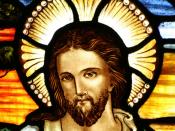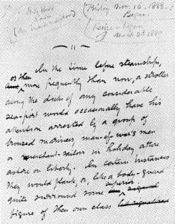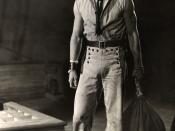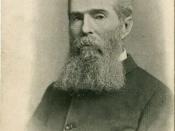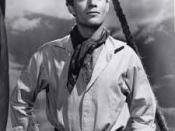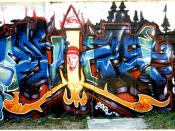Billy Budd Herman Melville wrote Billy Budd in the late eighteenth century and incorporated a lot of imagery and symbolism throughout it. Most of the imagery was religious, and alluded to different passages in the Bible. A great deal of the imagery was found in the chapters surrounding Billy's trail, and his death. The three main images were the chaplain's talk with Billy before his death, Billy's portrayal of the two views of Christ, and the comparisons throughout the story to various Bible stories.
Before Billy was to be hung, the ship's chaplain went and spoke to him about his death. That was customary in that the religion. The chaplain or priest would go to the person who was about to die, and he would preach to the person in hopes that he would repent and turn to God, and go to heaven. However, Billy did not need what the chaplain had to offer.
The chaplain felt that his innocence would serve him better in eternity than anything that he could have said to him. Billy was not afraid of dying; however, the chaplain was. That showed how Billy was perfect and did not need anything to help him to get to heaven. Melville used the character of the chaplain to illustrate that Billy is a Christ figure.
Billy portrayed two views of Christ. In one instance, he was the young innocent babe in the manger. Billy was abandoned as a child. He was laid in a basket and left on a doorstep. As Christ was laid in a manger, Billy was laid in a basket. The other view of Christ that he portrayed was the condemned man. In the Bible Judas and the Jewish leaders and Pharisees conspired against Jesus, and gave false testimony against Him. He was tried, found guilty, and was sentenced to death. Likewise, Billy was tried, found guilty, and sentenced to death. Claggart had conspired against Billy as Judas did to Jesus. Billy was hung on the mast, which was symbolic as the cross in which Christ died. Billy was both the innocent babe in the manger, and the condemned man.
Jesus Christ was not the only Biblical character that Melville made reference to in the book. Billy Budd was also like Adam, in The Garden of Eden before the fall. Adam was not born to any parents. He was created full grown by God; similarly, Billy seemed to have no parents. Adam fell as a result of the evil serpent's trick. Billy also fell because of a trick, Claggart's evil trick. In chapter 23, Captain Vere and Billy were compared to Abraham and Isaac when he was about to sacrifice his son. Abraham was faced with quandary of killing his own son, Isaac. Captain Vere was about the age where he could have been Billy's father. They had a father son sort of relationship. Vere was faced with the tough duty to give the orders to hang Billy. Another Biblical character that was mentioned in the story was Aninias. He and his wife sold some land and were supposed to give a certain percentage of the money to the Lord. Aninias lied about the amount and God struck him and his wife dead. Claggart lied to Captain Vere about Billy and he was killed. Vere said, " It is the divine judgment on Aninias!"ÃÂ God judged Claggart as He did Aninias in the Bible.
The Bible was the basis for much of Melville's imagery and symbolism in Billy Budd. Billy's death and his trial were the source for the majority of them. There were three main images. The first was the chaplain's talk with Billy about his eternity and death. The second was the two views of Christ that Billy represented- the babe in the manger, and the condemned man. The third was the various Biblical characters that were referred to throughout the story. Melville did this to advance his theme of good verses evil.
